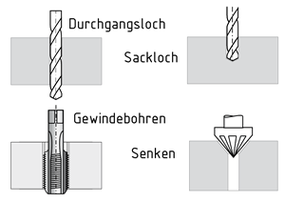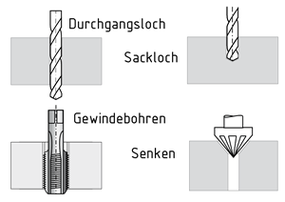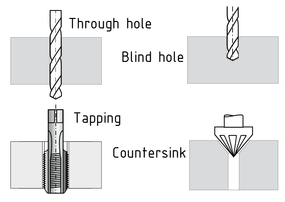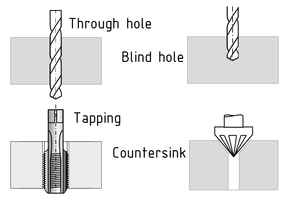
Choose one
or multiple languages
0,1,1
- German
- English
- Chinese
- Spanish
Drilling

Drilling is a Machining process in which a cylindrical or cone-shaped tool (drill in drill chuck, drill head on drilling bar) executes a rotary Cutting motion and a progressive feed in the direction of the rotational axis to produce cylindrical indentations (bores) in solid workpieces.
Tools include
- Spiral drill
- Double- and multi-edge countersinks
- Centre drill with centring pin
- Core drill
- Milling drill
- Sheet metal conical drill
- Step drill
- Tap
Spiral drills comprise a Shaft and a cutting part with a geometry that is designed for a particular task. Drills are distinguished by their profile, core thickness, flute geometry (maximum chip removal in tandem with high torsional Strength), helix angle, tip Grinding and tip angle.
To remove Material from the web of the spiral drill, the main cutting edges at the drill tip are connected by the chisel edge.
Bohren

Bohren ist ein spanabhebendes Verfahren, bei dem das zylindrische oder kegelförmige Werkzeug (Bohrer im Bohrfutter, Bohrkopf auf Bohrstange) bei drehender Schnittbewegung eine Vorschubbewegung in Richtung der Drehachse ausführt und dabei zylindrische Vertiefungen (Bohrungen) in festen Werkstücken herstellt oder bearbeitet.
Werkzeug-Ausführungen sind beispielsweise
- Spiralbohrer,
- Zwei- und mehrschneidige (Profil-)Senker,
- Zentrierbohrer mit Zentrierzapfen,
- Kernbohrer,
- Fräsbohrer,
- Blechschälbohrer,
- Stufenbohrer,
- Gewindebohrer.
Spiralbohrer bestehen aus Schaft und dem Schneidteil, dessen Geometrie seiner Aufgabe angepasst ist. Bohrer werden durch Profil, Kerndicke, Spannutengeometrie (möglichst großer Span-Transport bei hoher Torsionsfestigkeit), Drallwinkel, Spitzenanschliff und Spitzenwinkel charakterisiert.
Um vor dem Kern des Spiralbohrers Werkstoff zu entfernen, sind die Hauptschneiden an der Bohrerspitze durch die Querschneide verbunden.
钻孔

钻孔是一种加工工艺,是指使用圆柱状或圆锥状的工具(钻机固定在钻头夹盘上,钻头固定在钻杆上)执行旋转切割运动,并在旋转轴线的方向逐步进给,在固体工件中产生圆柱形缺口(孔)。
工具包括
螺旋钻
双刃或多刃埋头钻
带定心针的中心孔钻
岩心钻
铣钻
金属板锥形钻
阶梯钻
旋塞
螺旋钻包括一根轴和一个切割部件,其几何形状的设计适用于完成特定任务。钻的分类根据其型材、芯厚、沟槽几何形状(高抗扭强度下的最大随机排屑量)、螺旋角和顶锥角确定。
从螺旋钻的槽上移除材料,钻尖上的主切削刃通过凿尖相连。
各种钻孔方法
Perforación

La perforación es un proceso de maquinado en el cual una herramienta cilíndrica o en forma de cono (taladro en portabrocas, cabeza de perforación en barra de perforación) ejecuta un movimiento rotativo de corte y una alimentación progresiva en la dirección del eje de rotación para producir hendiduras (perforaciones) en las piezas de trabajo sólidas.
Las herramientas incluyen:
Taladro espiral
Avellanadores de borde doble y múltiple
Taladro central con clavija de centrado
Taladro de núcleo
Taladro de fresado
Taladro cónico para lámina
Taladro escalonado
De toque
Los taladros espirales comprenden un eje y una pieza de corte con una geometría que está diseñada para una tarea en particular. Los taladros se distinguen por su perfil, espesor de núcleo, geometría del canal (remoción máxima de viruta en tándem con una alta resistencia a la torsión), ángulo helicoidal, triturado de la punta y ángulo de la punta.
Para remover material de la red del taladro de espiral, los bordes de corte principales en la punta del taladro están conectados al borde de cincel.
Varios métodos de perforación
